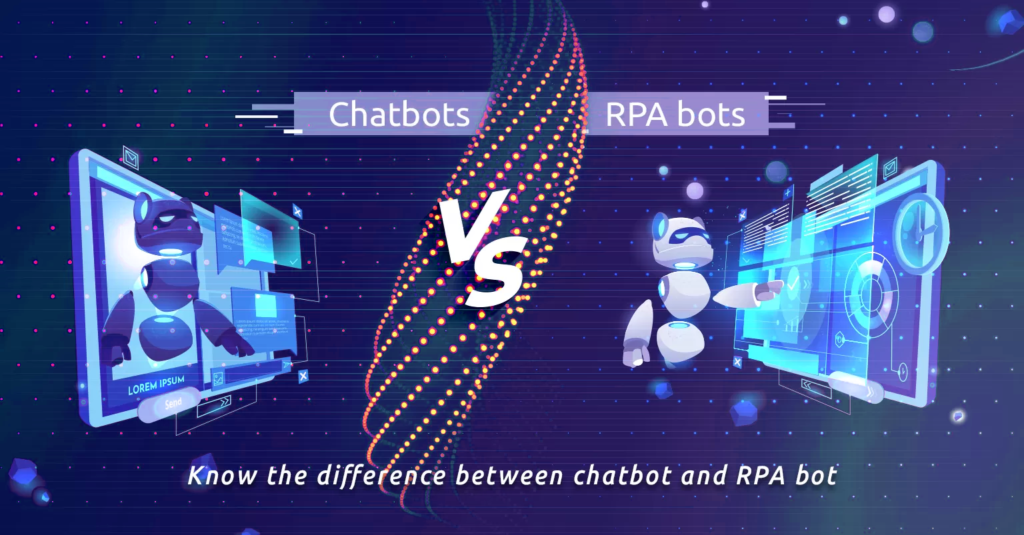Automation has become an integral part of business processes in today’s fast-paced world. Among the various automation tools, chatbots and RPA bots are two popular tools that are widely used. Although both are automation tools, there are some fundamental differences between them. In this blog, we will explore the difference between chatbots and RPA.
Chatbots – Conversational Automation
Chatbots are computer programs designed to simulate human conversations. They use natural language processing (NLP) and machine learning algorithms to understand the user’s query and provide a relevant response. Chatbots are commonly used for customer service, marketing, and sales. They are typically integrated with messaging platforms, such as Facebook Messenger, WhatsApp, or Slack.
Robotic Process Automation Bots – Task Automation
It is a software tool that automates repetitive and rule-based tasks that are performed by humans. These bots mimic human behaviour to perform tasks such as data entry, data extraction, and data manipulation. They are typically integrated with enterprise systems, such as CRM, ERP, and HRM, and can work across multiple applications.
Difference Between Chatbots and RPA Bots

The primary difference between chatbots and RPA bots is the type of automation they offer. Chatbots offer conversational automation, while bots (RPA) offer task automation. Chatbots are designed to interact with humans in a conversational manner and help, whereas RPA bots are designed to automate repetitive and rule-based tasks.
Implementation Complexity
Another significant difference between chatbots and RPA bots is the level of complexity involved in their implementation. Chatbots can be created using natural language processing (NLP) platforms, which require little to no programming skills. RPA bots, on the other hand, require a more technical skillset to design and implement. RPA bots require developers to create workflows, integrate systems, and handle exceptions, among other things.
Deployment Differences
Chatbots and RPA bots also differ in terms of their deployment. Chatbots are typically deployed on messaging platforms or websites, where users can interact with them. RPA bots, on the other hand, are deployed on servers or virtual machines and run in the background, performing tasks without any human intervention.
Benefits of Chatbots and RPA Bots
In terms of benefits, chatbots are primarily used to improve customer service and enhance the user experience. Chatbots can handle a large number of queries simultaneously, reducing wait times and improving customer satisfaction. RPA bots, on the other hand, are used to automate repetitive and time-consuming tasks, reducing errors and improving efficiency.
Conclusion
Both chatbots and Robotic Process Automation (RPA) bots represent invaluable automation tools that can substantially enhance business operations. Nevertheless, it is crucial to recognize that these technologies are distinctly purposed, catering to different facets of automation. Chatbots primarily furnish conversational automation capabilities, while RPA bots excel in task automation.
Chatbots, distinguished by their capacity for human-like conversations, are adept at interfacing with individuals and delivering assistance. They function as virtual agents, engaging in dialogues and providing information or support. This interaction can occur through text or speech, making them ideal for customer service, helpdesk support, and other scenarios where human interaction is integral.
Conversely, RPA bots are tailored for the automation of repetitive and rule-bound tasks. These bots are designed to navigate software systems in a manner akin to how humans interact with applications. They follow pre-established rules and sequences to perform data entry, data extraction, or other procedural tasks. RPA bots are particularly well-suited for activities such as data migration, invoice processing, and workflow automation, where precision and speed are paramount.
In essence, the choice between deploying chatbots or RPA bots hinges on the specific requirements of the business and the nature of the tasks awaiting automation. When seeking to enhance customer engagement, streamline inquiries, or offer real-time assistance, chatbots emerge as the tool of choice. Conversely, when confronted with high-volume, rule-based tasks demanding efficiency and accuracy, RPA bots prove their mettle.
In conclusion, a discerning assessment of the business process in question will ultimately dictate the most fitting automation solution. The judicious integration of these technologies can yield significant operational benefits, improving productivity, enhancing customer experiences, and driving overall efficiency.
























